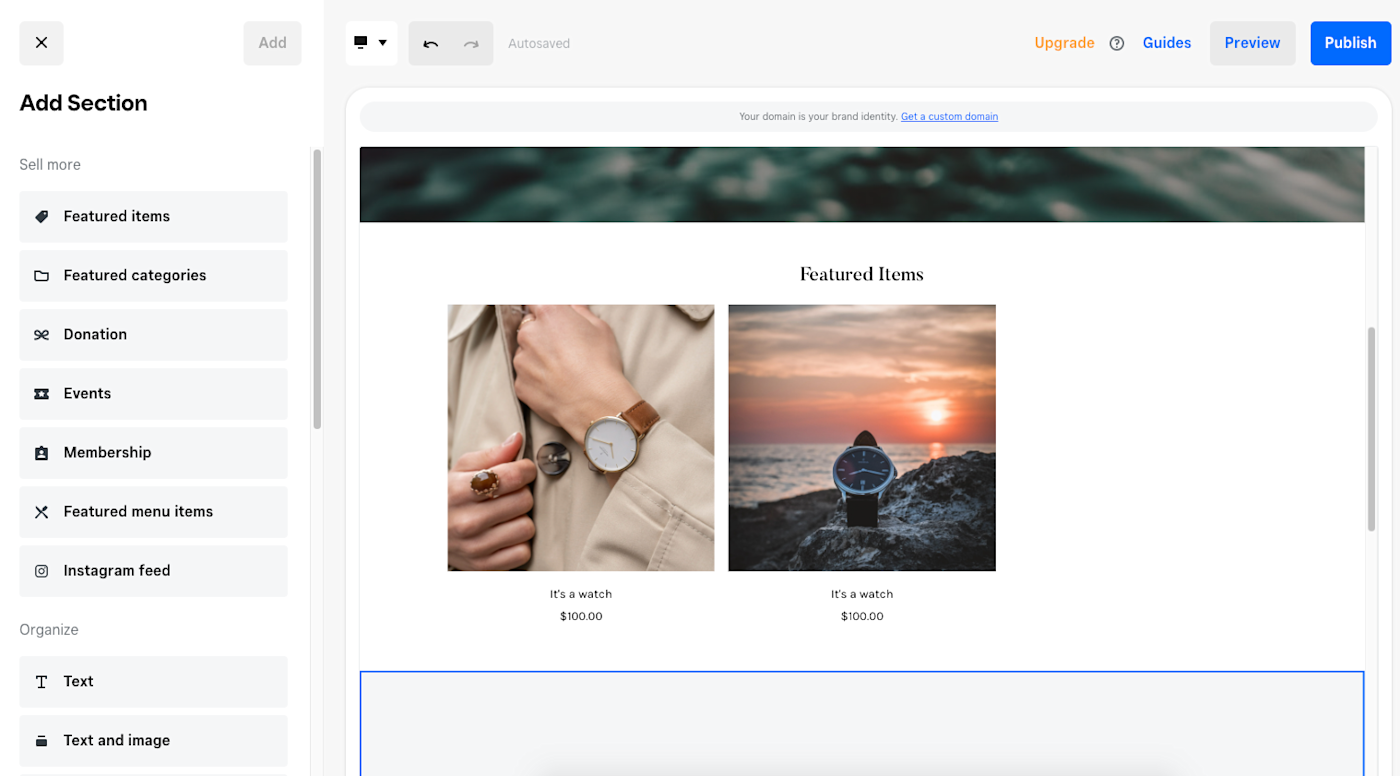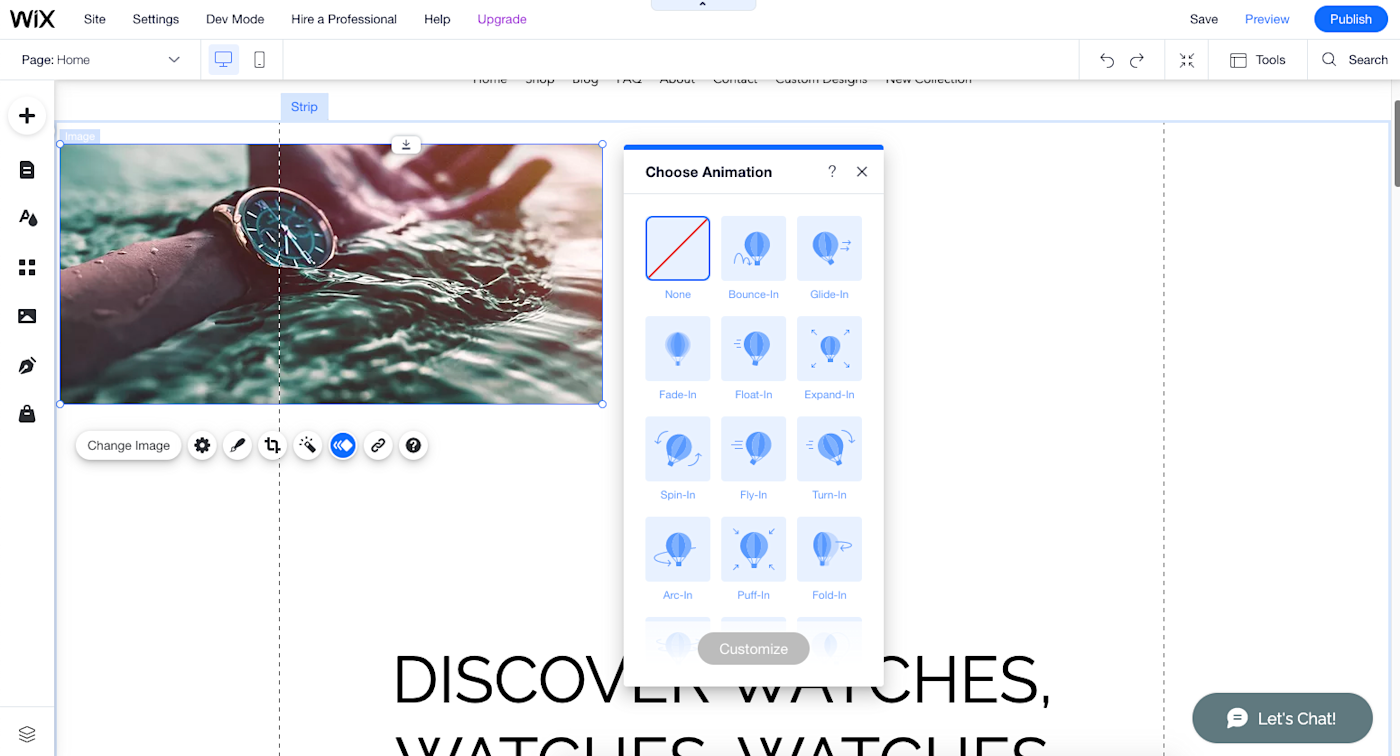I’ve spent my fair share of time building websites—as a chronically indecisive person, I ran a free trial of just about every platform out there before finally settling on a choice for my portfolio site. While most website builders claim to offer the same thing (easy-to-use site building tools), there are a surprising number of little differences that can really make or break your experience.
5 things you should automate today
Making a version of your site on every platform before picking one isn’t very efficient, though. That’s why I dove back into both Wix and Weebly to see how they stack up in 2022 and collected all the details you’ll need in order to decide between the two.
Wix vs. Weebly at a glance
Here’s the quick version:
-
Beginners and those with very minimal design goals will find that Weebly meets all of their needs for a lower price than Wix.
-
But if you want any real customization, or you’re an eCommerce seller who brings in even a modest amount of revenue, Wix is your best choice.
|
Wix |
Weebly |
|
|---|---|---|
|
Setup and ease of use |
|
|
|
Customizability |
|
|
|
Price |
|
|
|
eCommerce tools |
|
|
|
eCommerce fees |
|
|
What’s not different between Weebly and Wix
When comparing two platforms, it’s best to get the things they have in common out of the way. None of these things will be your decision-maker:
-
Easy setup: Both builders make creating and editing your site very easy—no tech or coding experience required.
-
SEO: Wix and Weebly both offer an SEO guide to walk you through optimizing your site for search, along with basic built-in SEO tools and compatibility with third-party SEO apps.
-
App integrations: Both sites have app stores with over 200 compatible integrations (many of which are free) to enhance your site’s marketing, selling, design, reporting, and more.
Wix’s editor lets you move things around at will; Weebly’s is a strict block layout editor
Both Wix’s and Weebly’s editors are pretty easy to set up and use, but Weebly is obviously designed to be as turnkey as possible. It’s almost impossible to mess up, but the trade-off is that you won’t be able to customize your site nearly as much.
That isn’t to say that Weebly doesn’t allow you to create a sleek, professional-looking site—it has a good variety of template themes you can start with, and you’ll be able to change colors and fonts, add logos, swap out photos, and rearrange the order of the blocks on the page to create clean, well-designed pages.

Within each block, though, you’ll only have a few preset layouts to choose from. There’s no drag-and-drop component to Weebly’s editor, so you can’t create your own custom layouts within each block. That’s not necessarily a bad thing—you just need to make sure that what you want your site to look like aligns with the options that Weebly offers.
Using Weebly feels kind of like bowling with bumpers: the limitations keep you in your lane and help you accomplish your goals, but if you want to do any cool trick shots, they’re going to get in the way.

Wix has a drag-and-drop editor that’s still pretty easy to use, and will also let you move things around more freely so you can create truly unique page layouts.
The setup process is definitely sleeker than Weebly’s—you can choose to start from scratch with a template or opt for an assist from Wix’s Artificial Design Intelligence (Wix ADI) program to get the basics taken care of. From there, you pretty much have free reign over customizing your site. Whereas Weebly limits you to stacked blocks, Wix will let you drag elements wherever you want on the page (for better or for worse).
Not only can you move the page’s elements around as you like, but Wix also provides PowerPoint-like animation options to dictate the way in which photos appear on the page.
If you’re not looking for anything fancy and you just want to get the site done and published as quickly as possible, Weebly is the faster, easier option. But if you have a unique look in mind for your site, Wix is the way to go.
Weebly’s free version is much more generous than Wix’s, and its plans offer more value for the money
Wix and Weebly both offer a free plan, but they’re very different in terms of what they offer. Wix’s free plan won’t let you accept payments at all, while Weebly offers a full suite of basic eCommerce tools for free.
Both free plans are limited to 500MB total storage, which is about 6 minutes of HD video. Weebly’s free plan has a per-file limit of 10MB, so you could upload 500MB of individual photos, but wouldn’t be able to upload a video file (unless it was really, really short). Wix doesn’t have a per-file limit on any of its plans, but its cheapest plan is $16/month, and it’s limited to 2GB of storage space and 30 minutes of hosted video space. Weebly offers unlimited storage for both of its higher-tier plans starting at $12/month.
If you’re planning to buy the high-tier plan either way, you’ll still save with Weebly. Wix’s Business Unlimited plan is $32/month, while Weebly’s full-feature plan is just $26/month and includes most of the same features.
That’s a lot of numbers to keep track of, so I created this table below to make it a little easier to figure out what you’ll actually have to pay to create your site on either platform. It shows the cheapest plan you would need to buy to get access to different features.
|
Wix |
Weebly |
|
|---|---|---|
|
Personal/portfolio sites |
||
|
No custom domain |
Free |
Free |
|
With custom domain |
$16/month |
$6/month |
|
With custom domain and no platform branding |
$16/month |
$12/month |
|
With video |
Free (no custom domain, 500 MB total file storage limit) |
$6/month (custom domain, 500MB total file storage limit) |
|
With more total file storage |
$16/month for 2GB $22/month for 5GB $27/month for 50GB $45/month for 100GB |
$12/month (unlimited storage) |
|
eCommerce |
||
|
No custom domain |
$27/month |
Free |
|
Custom domain |
$27/month |
$6/month |
|
Accept subscription payments |
$32/month |
The cost of whatever plan you’re using plus a $30/month add-on to accept subscription payments |
|
Sell digital goods |
$27/month |
$6/month |
|
Abandoned cart emails |
$27/month |
$26/month |
Both builders support selling, but Wix is better for eCommerce
Weebly allows all users, including those on a free plan, to accept payments and sell online products. The cheapest Wix plan that allows eCommerce selling is $27/month, and it still doesn’t support subscriptions, alternative currencies, or automatic tax calculations.
Though Weebly’s plans are more affordable, active eCommerce sellers will find that Wix is worth the extra cash up front. Weebly charges 2.9% + $.30 on all sales, even if you’re using their parent company, Square. If you want to accept payments from third-party providers like PayPal or Apple Pay, they’ll tack on an additional 3% fee. Wix charges the same 2.9% + $.30 transaction fee, but only if you’re using their native payments gateway—if you use a third-party processor, you’ll only have to pay whatever the processor charges.
Another big point scored for Wix: it allows you to sell on other channels like Facebook, Instagram, Amazon, and eBay. To sell via these channels with Weebly, you’ll need an add-on that costs between $25 and $99/month.
In other words: unless you’re only making a handful of sales, it will be more expensive to run your store via Weebly than Wix.
Weebly’s automation options are very limited
Once you’re up and running and you’re making a good amount of sales each month, you’ll likely need to start automating some of your processes in order to be able to juggle it all and maintain your sanity. Wix has an automations tool for that, but Weebly doesn’t.
Wix Automations allows you to set up triggers that will take a bunch of tasks off your plate, like sending emails, starting customer chats, and creating to-dos. Weebly doesn’t have a native automations tool. You can install an add-on, but there aren’t many to choose from, and they’re not as helpful as Wix’s native tool.
One thing worth noting: Weebly has a unique export function that allows you to zip your entire site and transfer it to a different host. Most other site builders can’t offer that because their site features are unique to their platform, while Weebly’s simplicity allows for easier transfer. So if you wanted to test the waters before diving fully into your eCommerce business, you could start with a cheaper Weebly site and transfer your entire site over to Wix if you decide to switch.
Wix vs. Weebly: which site builder makes sense for you?
Ultimately, Weebly’s rigid layout limitations make it more well-suited for beginners; most pros, or those who want to customize the look of their site, will find that Wix is the better option. Wix is also the better option for eCommerce sellers (despite the higher-priced plans) because of the fees involved with selling on Weebly. eCommerce sellers who are on the fence might get value from starting with a Weebly site, and then exporting it to Wix when they decide to invest more in their business.
Of course, Wix and Weebly aren’t the only website builders out there. Take a look at these guides to make sure you choose the platform that best fits your specific needs.
This article was originally published in March 2019 by David Harrington and has since been updated.
[adsanity_group align=’alignnone’ num_ads=1 num_columns=1 group_ids=’15192′]
Need Any Technology Assistance? Call Pursho @ 0731-6725516








